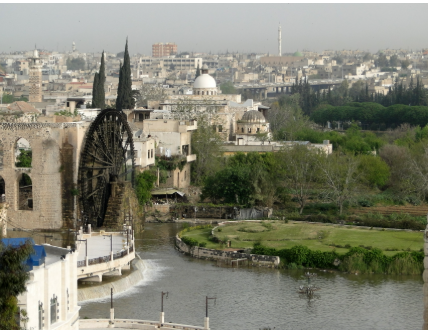Hama Governorate is located in central Syria and is considered a governorate of significant historical and agricultural importance. It spans an area of approximately 8,844 square kilometers and boasts a strategic location between plains and mountains, giving it significant natural and geographical diversity.
1. Historical Overview
Hama has a rich history spanning thousands of years, having been a vital area for civilizations such as the Amorites, Assyrians, and Romans. It is also known for its ancient stronghold, the famous Hama Citadel. It played a prominent role in Islamic history, especially during the Middle Ages when it was a center of science and culture. The region witnessed many political and military events that impacted Syria and the wider area.
2. What is it Known For?
- Agriculture: It is famous for producing grains like wheat and barley, in addition to fruits such as figs, dates, and grapes.
- Cultural Heritage: Hama Governorate is known for its ancient minarets and traditional waterwheels, or "Norias," which date back centuries and are a distinctive symbol of the city.
- Handicrafts: Such as the manufacturing of carpets and traditional textiles.
3. Key Tourist and Historical Landmarks
- Hama Citadel: A historical castle dating back to the Middle Ages, located in the city center.
- Waterwheels (Norias): Unique water systems used since Islamic times for water transport.
- Great Al-Nuri Mosque: One of the oldest mosques in the city, with its famous minaret.
- Old Souks: Which tell the story of trade and traditional handicrafts in the city.
4. Geography and Climate
The governorate's terrain varies between vast agricultural plains and smaller mountainous areas in the north. Its climate is hot and dry Mediterranean in summer, and cold and rainy in winter, making it suitable for cultivating a variety of crops.
5. Culture and Customs
The people of Hama have rich traditional customs, with a strong emphasis on religious and social occasions, where folkloric performances and traditional dances are vibrant during weddings and festivals. Hama's cuisine is known for dishes like "Shish Barak" and "Maqluba."
6. Economic Activities
Agriculture is the backbone of the governorate's economy, with a heavy reliance on grains, fruits, and vegetables. There are also small and medium-sized industries including food processing and traditional handicrafts. Local tourism contributes thanks to its historical and archaeological sites.
7. Major Cities and Towns
- Hama (Capital)
- Salamiyah
- Mhardeh
- Al-Ghab
- Al-Ghantoo
8. Infrastructure and Services
The governorate has a road network connecting it to neighboring governorates, as well as an internal network linking its cities and villages. Relatively good health and educational services are available, with multiple hospitals and health centers. Infrastructure in some rural areas requires continuous development.
9. Current Situation and Challenges
Hama was partially affected by the Syrian conflict, with some areas experiencing damage, but the governorate generally maintains relative stability compared to some other regions. The government and various entities are working on reconstruction and improving services, despite ongoing economic challenges.
10. Prominent Figures
- Numerous scholars and thinkers who contributed to Syria's cultural and political life.
- Artistic and literary figures from the governorate..

